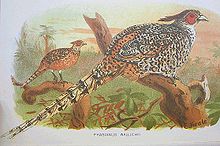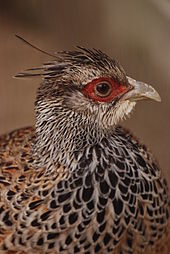- Cheer Pheasant
-
Cheer Pheasant 
Conservation status Scientific classification Kingdom: Animalia Phylum: Chordata Class: Aves Order: Galliformes Family: Phasianidae Subfamily: Phasianinae Genus: Catreus
Cabanis, 1851Species: C. wallichii Binomial name Catreus wallichii
(Hardwicke, 1827)The Cheer Pheasant, Catreus wallichii also known as Wallich's Pheasant is an endangered species of the pheasant family, Phasianidae. It is the only member in monotypic genus Catreus. The scientific name commemorates the Danish botanist Nathaniel Wallich.
Contents
Distribution
The Cheer Pheasant is distributed in the highlands and scrublands of the Himalayas region of India, Nepal, Kashmir and Pakistan. They are found mainly in the west of Nepal, Kumaon, Garhwal, Tehri Garhwal, Simla States, Bussahir, Chamba till about the Hazara District. Surveys in 1981 and 2003 in the Dhorpatan area of western Nepal established 70 calling sites, suggesting substantial numbers exist in this area (approximately 200 birds).[2][3][4] They are found mainly above 6000 feet altitude and up to 10000 feet in summer.[5]
 At Kyoto Zoo, Japan
At Kyoto Zoo, Japan
Physical characteristics
These birds lack the color and brilliance of most pheasants, with buffy gray plumage and long gray crests. Its long tail has 18 feathers and the central tail feathers are much longer and the colour is mainly gray and brown. The female is slightly smaller in overall size.
Biology and Social Behaviour
Males are monogamous. They breed on steep cliffs during summer with a clutch of 10 to 11 eggs.[5]
Conservation
Due to ongoing habitat loss, small population size and hunting in some areas, the Cheer Pheasant is evaluated as Vulnerable on the IUCN Red List of Threatened Species.[1] It is listed on Appendix I of CITES.[6] Attempts to reintroduce captive bred Cheer Pheasants in Pakistan have been unsuccessful.[7]
References
- ^ a b BirdLife International (2004). Catreus wallichi. 2006. IUCN Red List of Threatened Species. IUCN 2006. www.iucnredlist.org. Retrieved on 11 May 2006.
- ^ Lelliott, A.D.(1981) Cheer Pheasants in west-central Nepal. World Pheasant Assoc. 6:89-95
- ^ "PSG Project round-up". Newsletter of the WPA/BirdLife/Species Survival Commission. Pheasant Specialist Group. http://chinabird.org/news/TRAGOPAN%2019.pdf. Retrieved 14 January 2011.
- ^ "Dhorpatan Hunting Reserve". birdlife.org. Birdlife International. http://www.birdlife.org/datazone/sitefactsheet.php?id=14328. Retrieved 14 January 2011.
- ^ a b Baker, EC Stuart (1918) The game birds of India, Burmay and Ceylon. J. Bombay Nat. Hist. Soc. 26(1):1-5 scan
- ^ "Appendices I, II and III". cites.org. CITES. http://www.cites.org/eng/app/appendices.shtml. Retrieved 8 December 2010.
- ^ "Cheer Pheasant Catreus wallichi". birdlife.org. Birdlife International. http://www.birdlife.org/datazone/species/index.html?action=SpcHTMDetails.asp&sid=266&m=0. Retrieved 8 December 2010.
External links
Categories:- IUCN Red List vulnerable species
- Galliformes stubs
- Pheasants
- Birds of Asia
- Birds of India
- Birds of Nepal
- Birds of Pakistan
- Monotypic bird genera
- Animals described in 1827
Wikimedia Foundation. 2010.

